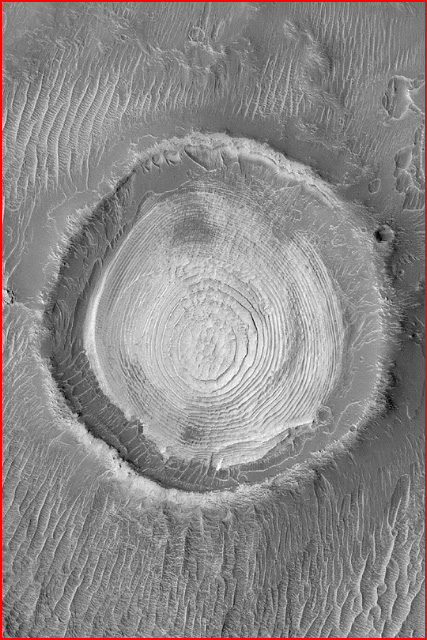|
|
||
 Credit: NASA/JPL |
||
|
pic of the day Links:
Society for
|
Nov 02, 2004 From the official caption: This old meteor impact crater in northwestern Schiaparelli Basin exhibits a spectacular view of layered, sedimentary rock. The 2.3 kilometer (1.4 miles) wide crater may have once been completely filled with sediment; the material was later eroded to its present form. Dozens of layers of similar thickness and physical properties are now expressed in a wedding cake-like stack in the middle of the crater. Sunlight illuminating the scene from the left shows that the circle, or mesa top, at the middle of the crater stands higher than the other stair-stepped layers. The uniform physical properties and bedding of these layers might indicate that they were originally deposited in a lake (it is possible that the crater was at the bottom of a much larger lake, filling Schiaparelli Basin); alternatively, the layers were deposited by settling out of the atmosphere in a dry environment Comments by Wal Thornhill: Sorry, the explanation above just doesn't hold water. It is a series of ad hoc mechanisms linked together with "may" and "might." To begin, it is baldly stated that the feature is an "old meteor impact crater." That is an opinion, not a fact. The floor of an impact crater is supposed to be formed of shattered rock. This crater floor is layered rock. So the crater "may have once been completely filled with sediment"-- or else the assumption is mistaken. Regular, episodic sedimentation is called upon to produce such even layering. Some method of cementation is also required to form each distinct layer. Whatever happened had to have repeated more than 20 times with precision to give such a regular appearance. Finally, "the material was ...eroded to its present form." We should like to know how that miracle was performed. Neither wind nor water moving across the landscape could produce the circular symmetry seen here. And it does not attempt to explain the strange landscape surrounding the crater. There is a better explanation. In an electric universe, surfaces and atmospheres of rocky planets are exchanged in the process of their electrical "birth" from a gas giant planet and in subsequent electrical interactions with other moons and planets in the process of achieving a stable orbit. Both Jupiter and Saturn have moons that would be classified as planets if they orbited the Sun. Saturn's moon, Titan, has an atmosphere heavier than Earth's. Later this year, when the Cassini spacecraft and Huygens probe arrive to observe it first-hand, Titan may have much to teach us about a planet that didn't manage to leave home. The birth of planets by expulsion, followed by accretion of the "afterbirth", leaves significant scars and layering on their surfaces, as does establishing a stable planetary orbit. Orbital dynamics tells us that two planets, which began in close association, will come together again at regular intervals. This would make the process of electrical deposition and erosion between the planets episodic and regular for a short time (geologically speaking). The result is a global "onion skin" build up of crustal materials together with various erratic mineral deposits. Superimposed are the effects of electrical erosion that occurs only upon the closest approaches between two planets (the same electrical forces that caused the initial expulsion preclude impacts). Electrical erosion tends to be concentrated hemispherically because of the short duration of closest approach. It also leaves the most dramatic scars. They take characteristic forms of circular craters (universally mistaken for impact craters), raised blisters (often mistaken for volcanoes), sinuous channels (usually mistaken for water or lava erosion channels), and etched or "fretted terrain" (no conventional explanation). The crater above can be explained simply by using the
electric universe model. The layering predated the crater. The crater is
electrical, not impact. The so-called erosion was an integral part of
the formation of the crater, caused by rotating Birkeland filaments.
Birkeland filaments twist in pairs to form a rope-like Birkeland
current. It is the form in which electrical energy is transported across
the cosmos. The current density is highest in the Birkeland filaments
themselves so the erosion rate falls off toward their center of rotation--the center of the crater. The result, in the sedimentary layers, is a
neatly terraced central peak, the untouched remains of previously
existing sedimentary layers.
|
|
|
Copyright 2004: thunderbolts.info |
||
